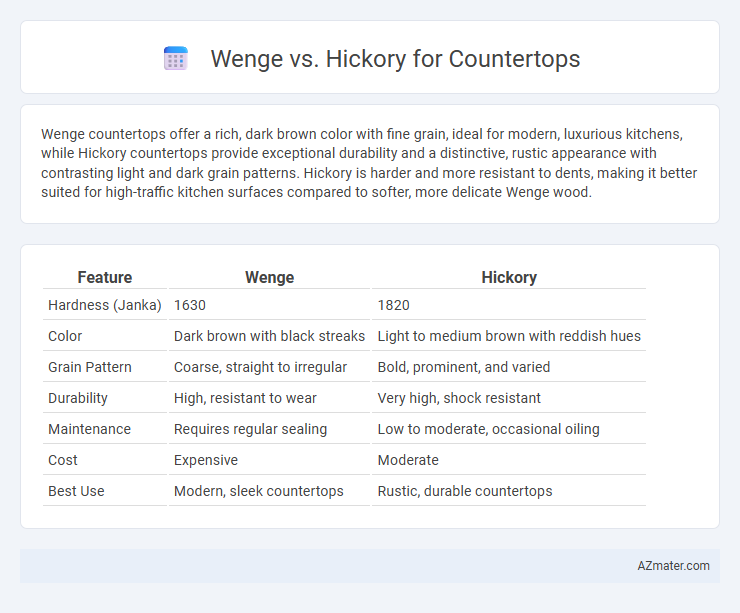Wenge countertops offer a rich, dark brown color with fine grain, ideal for modern, luxurious kitchens, while Hickory countertops provide exceptional durability and a distinctive, rustic appearance with contrasting light and dark grain patterns. Hickory is harder and more resistant to dents, making it better suited for high-traffic kitchen surfaces compared to softer, more delicate Wenge wood.
Table of Comparison
| Feature | Wenge | Hickory |
|---|---|---|
| Hardness (Janka) | 1630 | 1820 |
| Color | Dark brown with black streaks | Light to medium brown with reddish hues |
| Grain Pattern | Coarse, straight to irregular | Bold, prominent, and varied |
| Durability | High, resistant to wear | Very high, shock resistant |
| Maintenance | Requires regular sealing | Low to moderate, occasional oiling |
| Cost | Expensive | Moderate |
| Best Use | Modern, sleek countertops | Rustic, durable countertops |
Introduction to Wenge and Hickory Countertops
Wenge countertops, crafted from dark, dense African hardwood, are prized for their rich chocolate-brown color and striking grain patterns that add a sophisticated, modern touch to kitchens. Hickory countertops, sourced from a strong North American hardwood, offer exceptional durability and a warm, rustic appearance with varied color tones ranging from light to medium brown with occasional reddish hues. Both woods provide resilient surfaces, but Wenge is favored for contemporary aesthetics while Hickory complements traditional or farmhouse-style interiors.
Appearance and Color Comparison
Wenge countertops showcase a deep, rich chocolate-brown color with subtle black streaks, offering a sophisticated and modern look ideal for contemporary kitchens. Hickory countertops feature a lighter, golden to medium brown hue with pronounced grain patterns and natural knots, providing a rustic and warm aesthetic. The contrast between Wenge's dark, uniform appearance and Hickory's varied, textured look significantly influences design choices based on desired ambiance and style.
Durability and Hardness
Wenge offers exceptional hardness with a Janka rating of approximately 1630, making it highly resistant to dents and scratches, ideal for durable countertops. Hickory surpasses wenge in hardness, boasting a Janka rating around 1820, which provides superior resistance to wear and heavy impact. Both hardwoods provide long-lasting durability, but hickory's greater hardness makes it more suitable for high-traffic kitchen environments requiring robust countertop surfaces.
Maintenance and Care Requirements
Wenge countertops require regular oiling to maintain their rich dark color and prevent drying or cracking, while hickory countertops benefit from periodic sealing to protect against moisture and staining due to their porous nature. Both woods need gentle cleaning with mild soap and water, avoiding harsh chemicals that can damage the surface finish. Hickory's higher hardness offers better resistance to dents and scratches, but wenge's dense grain provides natural durability, making diligent maintenance essential for longevity in either material.
Cost Differences
Wenge countertops typically cost between $75 to $100 per square foot due to their exotic origin and rich, dark appearance, while hickory countertops range from $40 to $70 per square foot, offering a more affordable option with a lighter, rustic look. The higher price of wenge reflects its rarity and durability, making it a premium choice for luxury kitchens. Hickory's lower cost combined with its hardness and resistance to wear provides excellent value for budget-conscious homeowners seeking natural hardwood surfaces.
Sustainability and Eco-Friendliness
Wenge and Hickory differ significantly in sustainability and eco-friendliness when used for countertops. Wenge, sourced from African tropical hardwood forests, faces concerns over deforestation and limited regeneration, making it less sustainable compared to Hickory, which is widely abundant in North America and often harvested from sustainably managed forests. Hickory's faster growth rate, higher availability, and certifications from organizations like FSC contribute to its eco-friendly reputation in countertop applications.
Suitability for Kitchen Environments
Wenge offers exceptional durability and natural resistance to moisture and stains, making it highly suitable for kitchen countertops exposed to frequent spills and heat. Hickory's dense grain and hardness provide excellent scratch resistance and longevity, ideal for heavy-use kitchen environments where cutting and chopping are common. Both woods require regular sealing to maintain their appearance and protect against water damage in busy kitchen settings.
Customization and Design Options
Wenge countertops offer deep, rich tones with a natural grain pattern that complements modern and luxurious kitchen designs, allowing for unique custom finishes like matte or high gloss. Hickory provides a lighter, warm aesthetic with intricate knots and color variations, ideal for rustic or farmhouse-style countertops and versatile in staining and texturing options. Both woods support extensive customization, including edge profiles, inlays, and integrated sink designs, enabling tailored countertop solutions to suit diverse interior themes.
Pros and Cons of Wenge Countertops
Wenge countertops offer a rich, dark brown hue with striking grain patterns that provide a sophisticated and modern aesthetic, making them a popular choice for luxury kitchens. Pros include durability, resistance to wear and impact, and natural antibacterial properties, while cons involve susceptibility to scratches and dents, a tendency to darken over time, and higher maintenance needs compared to lighter woods like hickory. Wenge's dense structure requires regular oiling to maintain its luster, contrasting with the more rustic and lighter appearance of hickory, which is often favored for its hardness and distinctive color variations.
Pros and Cons of Hickory Countertops
Hickory countertops offer exceptional durability and resistance to wear, making them ideal for high-traffic kitchen areas. Their distinctive grain patterns and warm tones bring a rustic, natural aesthetic that complements a variety of interior styles. However, hickory wood tends to be harder to work with due to its density, and it can be prone to minor warping or cracking if not properly sealed and maintained.

Infographic: Wenge vs Hickory for Countertop
 azmater.com
azmater.com